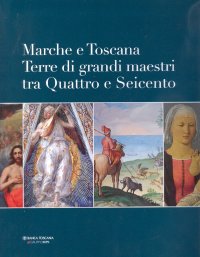Beato Angelico
Firenze, Palazzo Strozzi, September 26, 2025 - January 25, 2026.
Edited by Carl Brandon Strehlke.
Testi di Stefano Casciu, Marco Mozzo, Angelo Tartuferi.
Venezia, 2025; bound, pp. 456, 300 col. ill., cm 24x29.
cover price: € 80.00
|
Books included in the offer:
Beato Angelico
Firenze, Palazzo Strozzi, September 26, 2025 - January 25, 2026.
Edited by Carl Brandon Strehlke.
Testi di Stefano Casciu, Marco Mozzo, Angelo Tartuferi.
Venezia, 2025; bound, pp. 456, 300 col. ill., cm 24x29.
FREE (cover price: € 80.00)
Marche e Toscana. Terre di grandi maestri tra Quattro e Seicento
Ospedaletto, 2007; bound, pp. 320, col. ill., col. plates, cm 25,5x29.
FREE (cover price: € 77.00)
Segni dell'Eucarestia
Edited by M. Luisa Polichetti.
Ancona, Osimo, Loreto Jesi, Senigallia, Fabriano e Metelica, 23 giugno - 31 ottobre 2011.
Torino, 2011; paperback, pp. 221, b/w and col. ill., cm 24x28.
FREE (cover price: € 32.00)
Verso un'architettura sostenibile. Ripensare le nostre città prima che collassino. Toward Sustainable Architecture. Recreating our cities before they collapse
Ettore Maria Mazzola
Gangemi Editore
Translation by Rand P.
Introduction by Paolo Portoghesi.
Italian and English Text.
Roma, 2007; paperback, pp. 79, b/w ill., cm 17,5x24,5.
(Arti Visive, Architettura e Urbanistica).
series: Arti Visive, Architettura e Urbanistica
ISBN: 88-492-1208-9 - EAN13: 9788849212082
Subject: Civil Architecture/Art,Essays (Art or Architecture),Urbanism
Period: 1960- Contemporary Period
Languages: 

Weight: 0.28 kg
Ettore Maria Mazzola was born in Barletta (Italy) on July 17th, 1965; he took graduation in Architecture in 1992 at the University of Rome "La Sapienza" where, since 1993, he has taught as Assistant Professor. Since 2001 he has also worked as Visiting Assistant Professor of Architecture at the University of Notre Dame School of Architecture Rome Studies Program. Since 1993 he has worked as an architect in Rome, too. In 1993 he received, from the Minister for Foreign Affairs of Italy, a Bursary in Urbanism for the Summer Program of "Savaria" University of Szombathely (Hungary); in 1995 he won a Scholarship of the Prince of Wales' Institute of Architecture for the Summer School "Task Force for the City Civilized" Rome - Caprarola - Biarritz; in 1996 he was one of the representative members of Prince of Wales' Institute of Architecture for the Project "Urban Renewal of the area of the Oktober Theatre in St Petersburg"; again, in 1997 he was one of the representative members of the Prince of Wales' Institute of Architecture for the Project "Urban Renewal of the area of S. Maria in Gradi in Viterbo" (Italy); in 1999-2000 he worked as one of the members of the international team of the Prince of Wales' Alumni Foundation for the project of the New Neighbourhood Fonti di Matilde near Reggio Emilia (Italy) (team leader was Piercarlo Bontempi: in 2001 this project was rewarded with the Prize of "Congress for New Urbanism" as the best example of modern neighbourhood); in 2002 he received an honourable mention for his project in the International Competition of Architecture "Rione Rinascimento al Parco Talenti" in Rome; in 2006, the project for Pantelleria for the International Competition "Cities of Stones" made together with Samir Younés, Elisabetta Mannini, Vittorio Tortora and Paolo Vecchio, was rewarded with the publication and the exhibition at the Biennale of Venice; in 2006 was designed as member of the International Academic Committee of the INTBAU for The Venice Charter Revisited. He published several essays about Architecture and Urbanism; together with Samir Younés he edited the books: "Arpino - A New Neighbourhoods" Alinea 2003; "Como - The Modernity of Tradition" Gangemi 2003; "Artena - The recovery of urban integrity" Gangemi 2003; "Barletta - Sea-Centre and Periphery" Gangemi 2005; "San Giorgio a Liri - Re-integrating the dispersed city" Gangemi 2005; he also published the books "A counter history of modern architecture - Rome 1900-1940", Alinea 2004 and "Architecture and Town Planning - Operating Instructions", Gangemi 2006 with the introduction by Léon Krier; and the articles "Parigi oggi o Roma all'inizio del Novecento?" on the magazine Carta Etc. nr.5/2005 and "Sacrificati da Rutelli sull'Ara Pacis" on the magazine Carta Qui - Lazio e Roma, n°7/2006.











